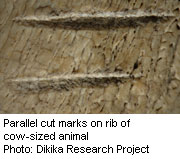
WEDNESDAY, Aug. 11 (HealthDay News) — Scientists excavating in Ethiopia have come across bones from a cow-sized animal and an antelope, probably eaten by early human ancestors, that seem to have been dug out by tools — probably to get the nutritious marrow out.
The bones are dated to about the time of Australopithecus afarensis, or the famous “Lucy” and her kin, which effectively moves back the date of the first known use of stone tools by hominins by almost a million years, from about 2.6 or 2.5 million years ago to 3.4 million years ago.
“The most obvious [value of the discovery] is that it pushes our knowledge of stone-tool use in the hominid lineage 800,000 years earlier than anything we previously knew,” said Jeffrey T. Laitman, distinguished professor and director of anatomy and functional morphology and of gross anatomy at Mount Sinai School of Medicine in New York City. “This is a quantum leap in our knowledge.”
The discovery changes the known evolutionary history of humans, said Zeresenay Alemseged, co-author of a paper on the discovery published in the Aug. 12 issue of Nature.
Not only must the record be changed to reflect that the earliest evidence for tool use and meat eating is now much earlier than previously thought, but it is also the first time that these behaviors have been attributed to A. afarensis, said Alemseged, who is curator of anthropology at the California Academy of Sciences in San Francisco and head of the Dikika Research Project, which made the discovery.
Previously, experts had thought that “these key human attributes [were] unique to the genus Homo,” he added.
The bones were found about 200 meters away from the bones of Selam, known as “Lucy’s Daughter” or, as Alemseged described her, “the earliest child.” Selam, who lived about 3.3 million years ago, is the most complete skeleton of a human ancestor and was also unearthed by the Dikika Research Project.
The researchers compared the marks on the fossils to experimentally generated images and also used scanning electron microscopes to examine the marks in detail.
The bones bore two types of distinctive markings, one “the result of carving meat versus pounding the bone to access the bone marrow,” Alemseged said.
Both these activities required “considerable forethought going on by our earliest ancestors to be able to understand what they were going to do to devise the type of tool that they would need to do it, and then to do the process,” Laitman said. “This is showing us about the level of cognition of thought that was starting to go on with our ancestors some 3.5 million years before the present.”
The Dikika research team was not able to determine if A. afarensis actually made the tools or if they just took advantage of available rocks.
The findings are also “an important statement on what our earliest ancestors were going for and eating,” Laitman said. “Our kind are meat eaters, and have evolved from a long line of meat eaters. We’ve always had the taste for the equivalent of a fast-food hamburger and this was their way of getting it.”
Alemseged, who was in the field and present at the exact moment the bones were upturned described his reaction as one of, “This cannot be true.”
“The age of the sediments we were working on was much older than what we knew was the earliest evidence of tool use and meat eating,” he explained. “Once the results were confirmed, there was a lot of excitement.”
“This is super-exciting. This is really an elegant piece of historical detective work, more riveting than any television CSI [crime scene investigation] story,” Laitman added. “They have managed to combine their anatomical, paleontological and archaeological skills with state-of-the-art technology to literally crack into the cracks made in the bones 3.5 million years ago. They don’t just have the tools. They have what the tools did, which in many ways is even more exciting.”
More information
The Smithsonian Institution has more on the evolution of humans.

